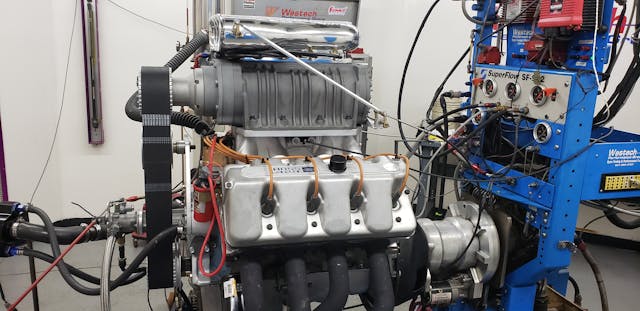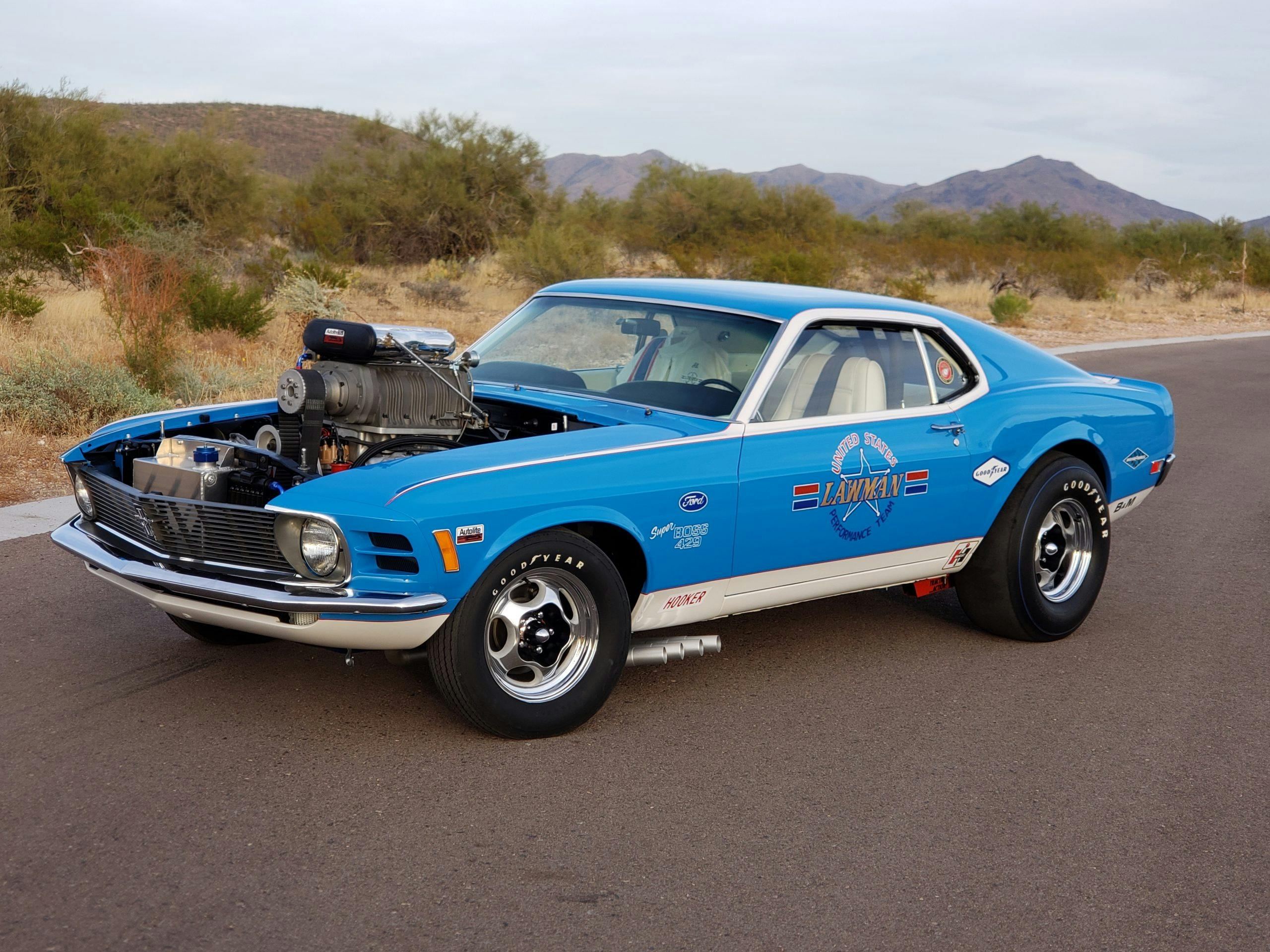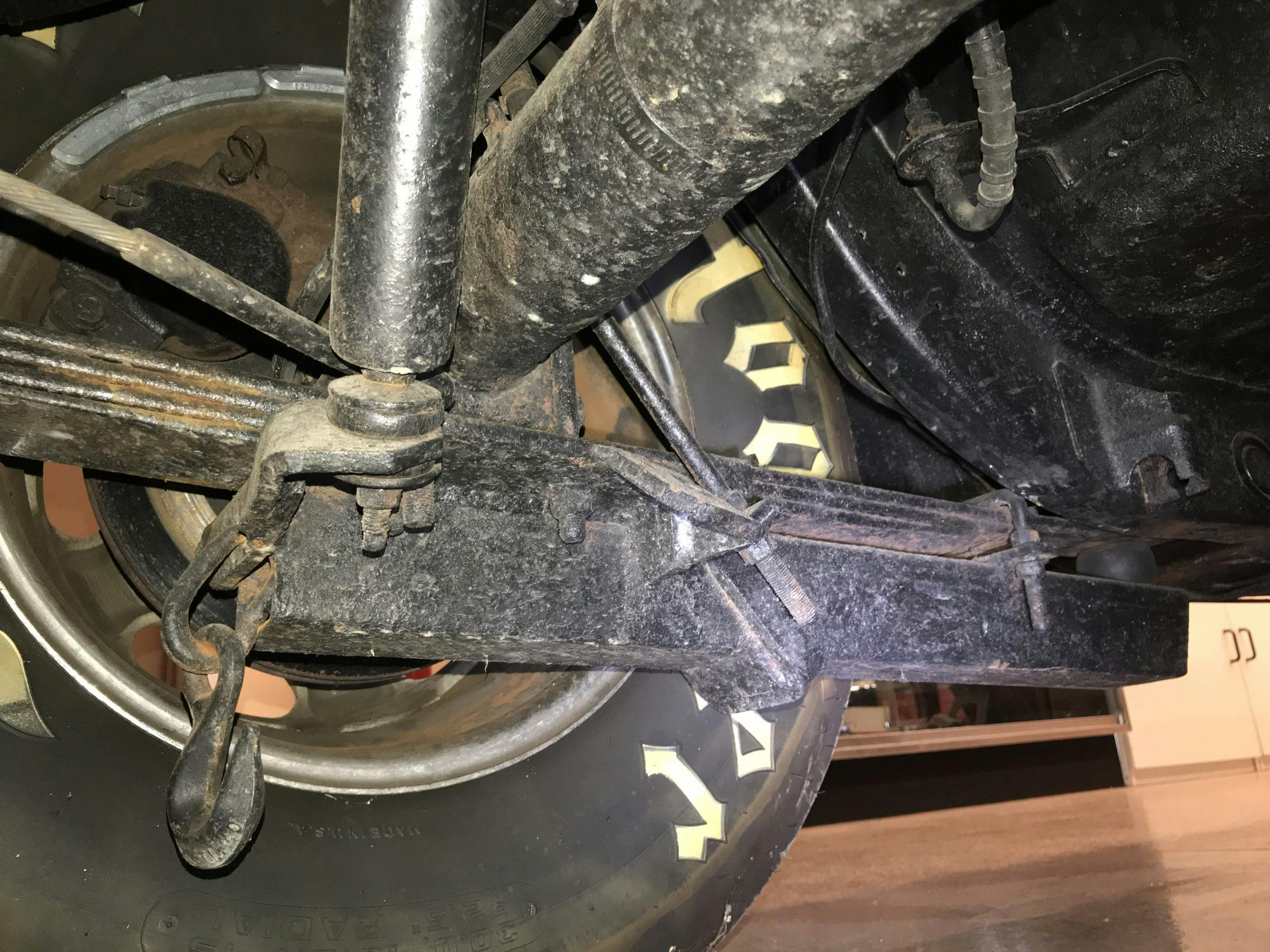Media | Articles
Lawman Mustang: The Boss 429 sent to war in the Pacific
Ford might be a major supplier of police-service Tauruses and Explorers today, but back in the 1970s, it supplied a handful of American promotional machines to a very different peace-keeping force. These “Lawman” cars toured the Pacific theater at several U.S. military bases. Just two of them made the journey home. One of these Lawman survivors—a magnificent Boss 429—has been restored to its former glory.
Credit Al Eckstrand with all things Lawman. Eckstrand was a fairly successful drag racer in the early 1960s, a side gig for his day job as a corporate lawyer at Chrysler. You’d be right to assume that his was something of a Jekyll and Hyde lifestyle, which he nodded at with the “Lawman” moniker that appeared on all of his drag cars. Eckstrand was good, too, holding several NHRA national records. That success, combined with his connections at Chrysler, let him run a Hemi Charger and big-block Barracuda through the latter part of the ‘60s. His ambitions, however, were bigger than this, and they included carrying the drag-racing torch overseas to Europe.

In 1966, with the help of Chrysler, Eckstrand formed the American Commando Drag Team. The mission was to take American muscle cars to England and Santa Pod Raceway, which had just opened up as the only 1/8- and ¼-mile drag strips in Europe. The cars would then tour military bases in Vietnam and other Pacific nations. American muscle cars were in high demand at the time, and this type of exposure promised to make big splash in a foreign market.
In 1970, Ford enlisted Eckstrand’s standard-bearing skills for a similar type of marketing program. The idea behind the Lawman Performance Team was to bring some of the latest Detroit muscle cars to the men and women of the Armed Forces who were serving overseas. A team of drivers went along with the cars to conduct demonstrations and seminars, all aimed at cutting down on a rash of street and highway crashes that had killed 55,000 people in 1969. Remember, this was when equipment like drum brakes and unassisted steering were standard, and even seat belts were considered a nuisance to some drivers.
Marketplace
Buy and sell classics with confidence

On January 14, 1970, in Detroit, Ford held a press party officially announcing the Lawman program. Ford worked with major sponsors including Goodyear, Motor Wheels, Hurst, and more to create six Lawman vehicles. Five of them were Cobra Jet cars, built in Dearborn and taken from the Ford assembly line to Roy Steffe Enterprises in Fairhaven, Michigan, where they were modified and converted for Military Performance Tour service. The sixth was a Boss 429 shipped from Kar Kraft, where all the other Boss 429s were built.
That lone Boss 429 was built to demonstrate not what was readily available from the dealer, but what a racer and hot rodder could do with it using old street-racing tricks and performance equipment. What emerged was a supercharged monster with close to 1000 horsepower mated to an automatic transmission. It was the only Boss 429 to be fitted with an automatic—all the other Boss 429s were four-speed cars.
The cars were transported to various military bases in Vietnam, the Philippines, South Korea, and Japan, where it is estimated close to 40,000 troops were able to see them in safety seminars and demonstrations. During the tour, the Boss 429 was accidentally destroyed when a shipping container fell on it, but the Performance Tour team managed to arrange for a replacement Boss 429 to be delivered. It’s this second car that you see featured here, with a VIN of XXX429.

Four of the Lawman Mustangs were left in place overseas, perhaps because the effort of bringing them back and prepping them for resale exceeded the reward. Two made it back to the States: a Cobra Jet and the supercharger 429. Ford Promotions stripped the Lawman lettering from the doors, pulled the Hampton blower, and eventually sold the latter to Dave McCormick, who raced in the Detroit area through the 1970s. He campaigned the car as the “Blue Devil”.

McCormick eventually passed away, and the Blue Devil was sold to one or more other owners until it ended up back in the hands of Al Eckstrand, who had returned from living in Europe sometime in the early 1990s. Eckstrand returned the car to its former Lawman-look glory and ran it for a few years before selling the car. The new owner let it sit for about a year until listing it to go across the block at Barrett-Jackson in 2003, which is how the car’s current owner, wrestler Bill Goldberg, bought it for his truly drool-worthy muscle car collection. It had a mere 890 miles on it when it crossed the auction block, and Goldberg was well aware of the car’s history.
“I was wrestling in Japan and Mr. Bob Johnson from Barrett-Jackson called and told me they had a Mustang called the Lawman that was about to go across the stage,” Goldberg explains. “I already knew the car, having watched a 60 Minutes episode about it, so I was very interested and ended up buying the car on the spot.”
Much of Goldberg’s interest stemmed from what the Lawman meant to service members. “Even if they couldn’t participate in the program to drive the cars, they could go to the window in the VA and see this car slamming down the tarmac. To them it represents what they were there fighting for. The red, white, and blue—it gave them every semblance that they knew about home.”
Given the car’s history, Goldberg knew that a restoration of the Lawman would demand thorough time and research. He went looking for a top-notch expert and found one in Marcus Anghel of Anghel Restorations in Scottsdale, Arizona. Both men consider this car the ultimate Boss 429. Once Marcus compiled and pored over all of the period photos and documentation to verify the compelling history, the real work could begin.
“I had been chasing after this car for years—as much as anything I just wanted to see the car with my own eyes,” says Anghel. “In the Mustang world this car has been legendary. I had to re-invent myself as not just an expert on restoring one of these early Mustangs or Boss 429s, but becoming well versed with early drag racing culture and creating a new network of people who helped with the restoration and historical information.”

Because both Anghel and Goldberg were so dedicated to doing this project justice, there were no set deadlines on finishing the restoration. “In discussing with Bill how to restore the car, he simply said to do it like it was my own car, which I did, paying attention to every single possible detail and putting it back to day-one condition,” says Anghel.
“It has to be done right, period. End of story,” insists Goldberg. “And if you want something done right and you can’t do it yourself, you find the best person to do the work, and that’s how I chose Marcus.”
The Lawman was torn down to an empty shell. The engine went out to Brian Duffee (Duffee Motorsports) for a rebuild—it had some valve-to-piston contact back in the day but the block is stock and numbers-matching for a Boss 429. In addition, Don Hampton built a new 8-71 blower (painted to look like the magnesium original) and the Hilborn mechanical fuel injection was refurbished. Joe and Bretina Perkins at American Traditions painted the car, and Efrain Gonzales applied the letting on the doors in true gold leaf. The assembly process took a while, as Marcus was careful to make sure that all the period-correct details were retained. The end result is a stunning restoration worthy of a one-of-one Boss 429 Mustang with a totally unique history.

Each nut, bolt, and screw on the car is period-correct, down to the original-style clamps that had to be specially sourced because the ones used in the late ‘60s and ‘70s did not have any metric measurements like the ones today. Even the parachute is 100 percent original. The fire extinguisher is a period-correct unit, dated from 1970 with a metal bracket and handle that’s unusual in comparison with modern units that use plastic. As for the tires, original slicks are notoriously difficult to find, but the Lawman restoration crew was able to scare up a set that had been stored for 50 years.
“So much of this car is not only wrapped up in the passion of the restoration but also respect and honor to the soldiers and community it served in that early part of 1970,” reflects Anghel.
Goldberg has the Lawman stored at his Texas ranch, but he’s thinking about the future. Plans for the car are as yet unclear, but deciding where it will go has been “a very intensive process,” the wrestler says. What’s for certain is that keeping this treasure of muscle car and U.S. military history alive is a debt of service, and worthy of salute.
































































That exhaust setup looks so crazy from the front of the car.
Good story for memorial day. Thank you for bringing it and thank you to all who have served. Especially take a moment to think of those who did not make it back.
Just so you know, the b&w photo of the cars at the airport…the planes are HC-97 Rescue aircraft, perhaps taken at Selfridge AFB/ANGB.
Happy Memorial Day.
Sure does look like Selfridge. I served there from 1972 to 1978.
Seeing these these cars must have been awesome for 17-20 year old boys that had dreams of having one when they got home.
55,000 didn’t return and we remember them today.
Amen
Please run an update if it ever goes on permanent display. Would love to see.
Awesome story for all our boys who served this Great Country!
Great story, Thank you
I wonder what happened to the cars that were left overseas.
The Henry Ford in Dearborn would be my choice for a future home.
I donated the rare NOS center caps for the Motor Wheel Spyder wheels. Nice to see the restoration finished.
Nice restoration but installing 50-year-old slicks on a high performance drag car is asking for trouble. Rubber deteriorates over time, even when tires are stored indoors and away from sunlight and ozone. Tires should be replaced if they are more than 10 years old regardless of tread wear or how they look. In Europe, tires must be replaced after 6 years.
I don’t think this car is going to be driven.
Given the age of the slicks, I guess a burnout isn’t in the plans for the future:-(
Seems like this car would be a worthy candidate for the National Automobile Museum. Would look nice out in the park in the glass box for all to see and remember. Thanks for the article, a fitting tribute to our soldiers serving, and the ones that gave their all for our dear country. May we turn back to God for his blessing.